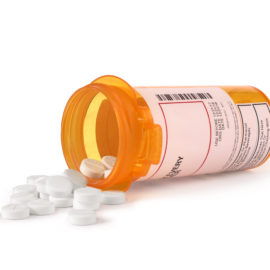Blue Xanax is one of many versions of alprazolam, a prescription benzodiazepine and Schedule IV controlled substance.
While benzos like blue Xanax can be highly effective, they also have the potential for abuse and addiction.
What Is Xanax?
Xanax is alprazolam in branded form. Xanax is classified as benzodiazepine and belongs to the same family as Valium, Klonopin, and Ativan.
One of the most prescribed psychotherapeutic medications in the United States, blue Xanax is typically prescribed for the short-term relief of panic disorders and anxiety disorders.
Xanax has a mechanism of action that reduces activity in the central nervous system and brain – alprazolam is a CNS depressant. The depressant properties of Xanax trigger a sense of calm, intensifying the effects of GABA (gamma-aminobutyric acid), a chemical that occurs naturally in the brain.
Approved by the FDA in 1981, physicians still prescribe Xanax widely today despite its strongly habit-forming nature.
What Is Blue Xanax?
Blue Xanax pills, also known as blue Xanax bars, are oval and imprinted with XANAX 1.0. The imprint expresses the dosage of 1mg of alprazolam.
If you are prescribed Xanax for panic disorder or anxiety disorder, the starting dose is typically as low as 0.25mg. Dosage can be gradually increased as you become accustomed to the effects of benzodiazepines. The maximum daily dose of Xanax in adults is 4mg split across multiple doses.
When Blue Xanax is taken as directed, the effects set in within an hour. Blood concentration levels of Xanax peak within two hours.
Many people abuse blue Xanax, often by crushing the pills and then inhaling powdered Xanax through the nose. This triggers almost immediate effects and is an especially damaging form of Xanax abuse.
Blue Xanax and Other Types of Xanax
Xanax comes in many different shapes, sizes, and colors. Alprazolam is also available in generic form. Drug manufacturers stamp their brand and imprint on their formulation of alprazolam so they can stand out in a crowded segment of the drug market– blue pill l368, for instance.
Branded Xanax pills come in different colors because they contain different FDA-approved colorants to differentiate the strength of the pills. These are the most common variants of Xanax:
-
- Blue Xanax: All blue Xanax bars are Schedule IV controlled substances only available with a prescription. Blue pills contain just 1mg of alprazolam, while blue bars contain 2mg of alprazolam. The bars are designed to be broken in half if fractional dosing is required. Blue Xanax pills carry the imprint 031 R by Actavis. The blue colorant is an inactive filler approved by the FDA as safe for human consumption.
-
- White Xanax: White Xanax, informally known as sticks, is the most common colored variants of Xanax. White bars contain 0.25mg to 2mg of alprazolam.
-
- Yellow Xanax: Generic Xanax pills are yellow and contain 2mg of alprazolam.
-
- Purple Xanax: Pfizer manufacture purple Xanax pills imprinted with XANAX A23.
-
- Peach Xanax: Peach or orange Xanax bars contain 0.5mg of alprazolam. This variant of Xanax is also manufactured by Pfizer.
-
- Green Xanax: Green Xanax bars come in many variants, each imprinted with characteristics of the drug manufacturer. Green Xanax contains 2mg of alprazolam.
-
- Pink Xanax: Xanax in pink form contains 3mg of alprazolam and is rarely prescribed.

Blue Xanax Abuse and Addiction
The sustained use of Xanax is liable to lead to physical dependence. The risk of developing dependence and addiction is heightened if you take alprazolam without a prescription, or if you use more Xanax than directed.
Long-term use of benzos causes tolerance to form. When this occurs, the effects of the drug are diminished. This often leads to abusive patterns of consumption, with more Xanax consumed or more frequent doses taken. Xanax abuse accelerates the formation of physical dependence. When you become dependent on benzodiazepines, you will experience intensely unpleasant withdrawal symptoms if you discontinue use.
Xanax addiction is classified as a substance use disorder. The diagnostic criteria for substance use disorders are detailed in DSM-5-TR (the revised fifth edition of Diagnostic and Statistical Manual of Mental Disorders). Substance use disorders are diagnosed according to the number of criteria that present as mild (2 to 3), moderate (4 to 5), or severe (6+).
The symptoms of Xanax addiction are:
-
- Intense cravings for Xanax.
-
- Tolerance to Xanax forming.
-
- Taking more Xanax or using the benzo more frequently.
-
- Spending lots of time obtaining and using Xanax, as well as recovering from the effects.
-
- Ongoing Xanax use even though it is causing you to neglect personal and professional obligations.
-
- Continuing to use Xanax even though it is causing interpersonal or social problems.
-
- Giving up hobbies and interests to use Xanax.
-
- Using Xanax in dangerous situations.
-
- Recurrent Xanax use despite the medication causing physical or psychological complications.
-
- Inability to moderate or discontinue use of Xanax.
-
- Withdrawal symptoms presenting in the absence of Xanax.
Detoxing from Xanax
If you are addicted to Blue Xanax bars or any benzodiazepine, it is never advisable to abruptly discontinue use without medical supervision.
When you stop using Xanax, acute withdrawal symptoms will manifest. If untreated, these symptoms may be life-threatening.
Fortunately, the Xanax withdrawal process can be significantly streamlined by gradually tapering the dose. A long-acting benzo may be prescribed to replace the short-acting Xanax during the tapered reduction. Tapered withdrawal can reduce the severity of symptoms. Dosage is typically reduced by 0.5mg every three days.
It’s important to note that you should not detox from benzodiazepines like Blue Xanax at home. The side effects of breaking dependence on your own can result in dangerous health risks, potentially causing permanent damage or even death. Finding a good medical detox program will make this process safe, more comfortable with medication-assisted treatment, and 24/7 medical supervision.
We can help you reclaim your life from blue Xanax addiction here at Gratitude Lodge in Southern California.

Xanax Addiction Treatment at Gratitude Lodge in Southern California
If you have developed an addiction to Blue Xanax bars or any other benzodiazepine, build the firmest foundation for recovery at Gratitude Lodge in Southern California. We offer benzo rehab in Long Beach, Newport Beach, and San Diego.
All Gratitude Lodge rehab centers are pet-friendly environments free of triggers, temptations, and distractions.
Before engaging with ongoing treatment, streamline Xanax withdrawal with our supervised medical detox program. A tapered reduction in dosage will mitigate many of the withdrawal symptoms associated with benzo detox. After Xanax is purged from your system, you can transition into one of the following treatment programs:
-
- Inpatient treatment program
-
- IOP (intensive outpatient treatment program)
-
- Dual diagnosis treatment program (for co-occurring disorders)
Your treatment team will draw from the following evidence-based and holistic interventions to create an individualized treatment plan:
-
- Group therapy
-
- Individual counseling
-
- MAT (medication-assisted treatment)
-
- Psychotherapy
-
- Family therapy
-
- Holistic therapies
Reach out to admissions today by calling 800-994-2184 and start detoxing from Blue Xanax bars as safely and comfortably as possible.




























